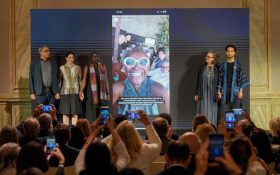The funny thing about cadaver art is that nobody claims to make it. Those responsible for the exhibitions of corpses that have labelled by the media as “cadaver art”, say they are educators who create scientific exhibits. Their aim is to educate audiences by offering spectators an inside view of the human body. They might arrange the cadavers with an aesthetic sense but they don’t make any claim to be artists, or that their exhibits contain works of art. So why have they been labelled as such?
One person embodies cadaver art more than any other, Gunter von Hagens. In 1978 the German anatomist, working out of a laboratory in Heidelberg (Germany), developed a technique known as plastination. The process replaces water and lipids in biological tissues with plastic polymers to produce an odourless and preserved specimen. It allows the anatomist to skin, dissect and then contort the body virtually any way he likes before putting it on display. And display them he has.
Von Hagens was quick to patent his plastination technique before establishing his international Body Worlds touring exhibition, allegedly seen by more than 8 million people worldwide. The exhibition, which has wowed audiences across the USA, features cadavers in athletic positions, such as a man playing basketball and the skateboarder pulling an invert. There is also the plastinated body of a pregnant female whose stomach has been cut in half to reveal the foetus.
It may sound gruesome but von Hagens insists his work is helping educate both students of anatomy and ordinary people to understand the mysteries of the human body. Body Worlds is marketed as, “The anatomical exhibition of real human bodies.”
The Body Worlds website states that the exhibitions’ primary goal is “health education.” Body parts of smokers are displayed alonside those of non-smokers to highlight the health effects of lifestyle choices. “On the other hand,” the website reads, “life-like posed whole-body plastinates illustrate where in our bodies these organs are positioned and what we are: naturally fragile in a mechanized world.” Not surprisingly von Hagen’s success has spawned imitators. But importantly all of the exhibitions operate on the education premise. None of them make any claim to display works of art. So why has it been labelled art, and why?
Controversy. It has plagued von Hagen’s career. Every time a Body Worlds exhibition, or one of the copycat exhibits, opens up in a new place the debate about whether it should be allowed flares up. Is “cadaver art” objectionable on moral grounds. Are the exhibitions an affront to the deceased who play such a starring role in them? Were the bodies acquired ethically and did the deceased give consent that their bodies or organs would end up in the exhibition. Not to say that contentious issues aren’t applicable to science, but controversy surrounding the work of artists’ work on display is commonplace. The way bodies are presented is closer to what you’d expect to find in a gallery than a science text book. So in describing von Hagens’s work some journalists have elected to paint him as a mad scientist turned artist.
Clearly they do not accept von Hagens claims that all he wants to do is display cadavers in order to enlighten viewers about death and the human form. The inference is that only an artist would be base enough to put corpses on display. What’s interesting is that the same claims have never been made against museum educational displays featuring dinosaurs and neandertals posing in scenarios supposedly recreated from the past. Are these exhibitions art, too?
Just because Body World’s isn’t formatted like a boring text book, journalists have decided it must be a form of art, despite the fact there are no artists claiming to be present. As von Hagens says: “Critics say this is a piece of art, I say it’s a piece of enlightenment.” In labelling von Hagen’s work as art, these journalists are making a link between the ability of art to reveal the mysterious aspects of the human condition. And even though von Hagen’s and the copycat “cadaver curators” have no artistic pretensions, journalists continue to make the link. In doing so they are perpetuating the negative association between art and subjects that are taboo.
Artists have enough trouble overcoming unfounded prejudice against their work without being linked to a morally sensitive series of exhibitions that has (at the moment at least) nothing to do with art, as it is not being propogated by artists. The controveries that have nipped at von Hagen’s heels as he laughs all the way to bank the tremendous profits he has accrued through Body Worlds have been inappropriately linked with art. After all, without artists there can be no such thing as cadaver art.




